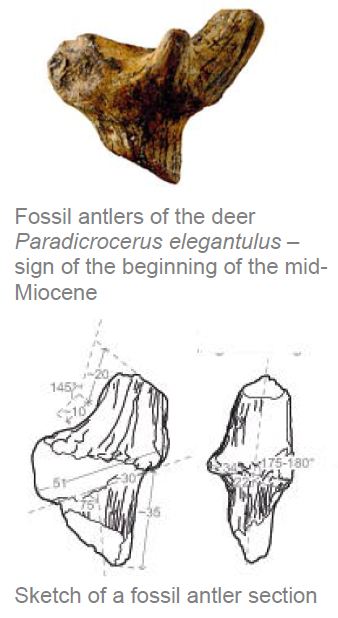Based on new fossil evidence, the age of the Rhine river is five million years older than previously believed.
The famous Rhine of song and legend flows through Switzerland, Austria, Germany and the Netherlands on its way to the North Sea. The catchment area of the Rhine, around 1,200 kilometers of it, draws from Luxembourg, Belgium, France, Lichtenstein and Italy. As widely known as the river is, its original age has remained a science puzzle.
The consensus has been that the Proto-Rhine is around ten million years old, explains Prof. Madelaine Böhme, leading author of a new study and head of the Senckenberg Center for Human Evolution and Palaeoecology (HEP) working group Terrestrial Palaeoclimatology at the University of Tubingen, says now, "based on our examination of fossils from a site near Sprendlingen we now believe that the river is at least five million years older. "

Credit: Senckenberg Museum
The mammalian fossils in the Sprendlingen and Eppelsheim areas have been considered for 200 years by vertebrate palaeontologists to be the yardstick for the Neogene; the time span between 23 million and around 2.5 million years ago. The sites became famous around the world for the first ever discovery of a fossil ape (1822) and the first scientific descriptions of 19 large mammal species in the early 19th century.
The allocation of a time period to the Deinotherium sands that were found there and which contain numerous other fossils along with the teeth and bones that provided the name of the proboscidean has often been the subject of scientific debate.
"For this reason we examined a new sample with over 300 mammalian fossils, leaves and fossilized wood. In the process we found the teeth and bones of different deer species that lived in Central Europe at the beginning of the Middle Miocene in other words, in the period between 14 and 16 million years ago," explains Böhme. "The results of the examinations of fossil plant residues that were found above and below the mammalian sites reinforce our conclusions."
The results provide new insight regarding the development of the Main Basin and the Upper Rhine dig in geological history. Because the findings were made in the oldest known deposits of the Rhine, they conclude it must also be at least five million years older.

Credit: Senckenberg Museum
The conclusions of the scientists have an impact upon the entire chronological categorization of the flora and fauna of the Middle to Late Miocene time - but until now the sites near Sprendlingen had been a timing determinant for palaeontologists only.
The famous Rhine of song and legend flows through Switzerland, Austria, Germany and the Netherlands on its way to the North Sea. The catchment area of the Rhine, around 1,200 kilometers of it, draws from Luxembourg, Belgium, France, Lichtenstein and Italy. As widely known as the river is, its original age has remained a science puzzle.
The consensus has been that the Proto-Rhine is around ten million years old, explains Prof. Madelaine Böhme, leading author of a new study and head of the Senckenberg Center for Human Evolution and Palaeoecology (HEP) working group Terrestrial Palaeoclimatology at the University of Tubingen, says now, "based on our examination of fossils from a site near Sprendlingen we now believe that the river is at least five million years older. "

Credit: Senckenberg Museum
The mammalian fossils in the Sprendlingen and Eppelsheim areas have been considered for 200 years by vertebrate palaeontologists to be the yardstick for the Neogene; the time span between 23 million and around 2.5 million years ago. The sites became famous around the world for the first ever discovery of a fossil ape (1822) and the first scientific descriptions of 19 large mammal species in the early 19th century.
The allocation of a time period to the Deinotherium sands that were found there and which contain numerous other fossils along with the teeth and bones that provided the name of the proboscidean has often been the subject of scientific debate.
"For this reason we examined a new sample with over 300 mammalian fossils, leaves and fossilized wood. In the process we found the teeth and bones of different deer species that lived in Central Europe at the beginning of the Middle Miocene in other words, in the period between 14 and 16 million years ago," explains Böhme. "The results of the examinations of fossil plant residues that were found above and below the mammalian sites reinforce our conclusions."
The results provide new insight regarding the development of the Main Basin and the Upper Rhine dig in geological history. Because the findings were made in the oldest known deposits of the Rhine, they conclude it must also be at least five million years older.

Credit: Senckenberg Museum
The conclusions of the scientists have an impact upon the entire chronological categorization of the flora and fauna of the Middle to Late Miocene time - but until now the sites near Sprendlingen had been a timing determinant for palaeontologists only.
Citation: Madelaine Böhme, Manuela Aiglstorfer, Dieter Uhl, Ottmar Kullme, 'The Antiquity of the Rhine River: Stratigraphic Coverage of the Dinotheriensande (Eppelsheim Formation) of the Mainz Basin (Germany)', PLoS ONE, http://dx.plos.org/10.1371/journal.pone.0036817





Comments